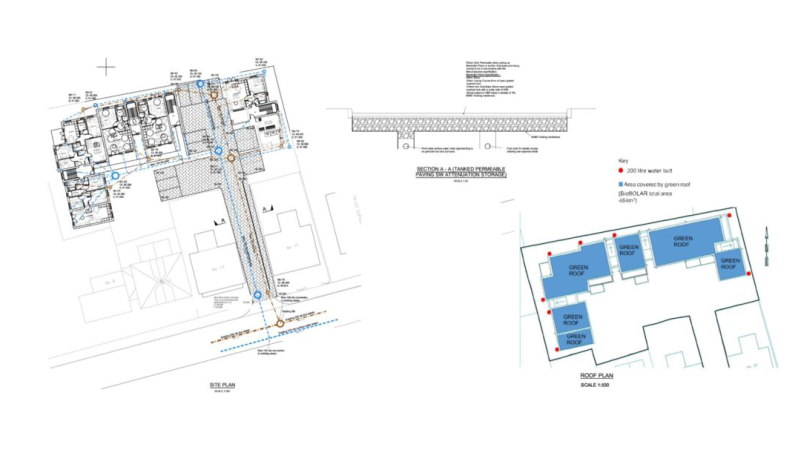Drainage Strategy
Principles
Drainage Strategies, or Sustainable Drainage Strategies (SuDS) Maintenance Plans can be produced as stand alone documents or to accompany our flood risk assessments.
The aim with SuDS is to attempt as far as practicable to achieve natural drainage of surface water, ideally allowing rainfall to soak into the ground where it falls. In this way aquifers are recharged and the risk of flooding from overwhelmed sewers is reduced. SuDS features include; permeable surfaces, swales, rainwater gardens and ponds. Planning Practice Guidance states: “Where possible, preference should be given to multi-functional sustainable drainage systems, and to solutions that allow surface water to be discharged according to the following hierarchy of drainage options:
- into the ground (infiltration);
- to a surface water body;
- to a surface water sewer, highway drain, or another drainage system;
- to a combined sewer.”
Planning Practice Guidance further advises:
"Multifunctional sustainable drainage systems are those that deliver a wider range of additional biodiversity and environmental net gains such as to:
- ameliorate urban heating and air pollution;
- replenish groundwater resources;
- contribute to biodiversity net gain targets;
- capture and re-use rainwater;
- store carbon;
- reduce the need for carbon-intensive construction techniques and pumped systems;
- release capacity in combined sewerage systems and at wastewater treatment works;
- create and connect valuable areas of blue-green infrastructure
- reduce lifetime maintenance costs; and
- enhance the attractiveness and value of new development by integrating water management with habitat for wildlife and opportunities for amenity and recreation."
What is achievable depends on many factors, including the permeability of the ground, whether there is any contamination present and the nature and scale of the development. Well planned SuDS have the potential to both reduce costs by removing the need for some elements of traditional drainage and to enhance the environment within the development.
SuDS in Contaminated Land
Implementing SuDS on contaminated land can be challenging due to the risk of spreading contamination. However, with careful planning, SuDS can play a role in remediation strategies. Early engagement is vital to ensure cost effective solutions. Here are some ways they can be utilized:
- Risk Assessment: SuDS can be incorporated as part of a risk-based approach to managing contaminated land. This involves assessing the contamination levels, identifying potential exposure pathways, and using SuDS to manage and treat runoff in ways that limit these exposure pathways.
- Containment and Control: In cases where the contamination cannot be entirely removed or degraded, SuDS can be used to contain and control the spread of contamination. This could involve constructing barriers or buffers to contain contaminated runoff or designing the SuDS to control the direction and speed of runoff to prevent it from reaching sensitive areas. In some cases water from swales & porous paving can be collected and discharged at levels beneath any potentially contaminated ground.
- Attenuation and Filtration: SuDS such as permeable paving, swales, and basins can provide filtration for runoff, reducing the load of suspended solids and associated pollutants. Bioretention areas, such as rain gardens, can also remove contaminants from runoff through adsorption, filtration, volatilization, ion exchange, and microbial processes.
- Phytoremediation: This technique uses plants to remove, stabilize, or degrade contaminants in the soil and water. Certain types of SuDS, such as constructed wetlands, swales, or rain gardens, can incorporate plant species known for their phytoremediation abilities. These plants can take up heavy metals or other pollutants from the soil, reducing the overall contamination level.
- Monitoring and Maintenance: In some instances regular monitoring and maintenance may be required to ensure the SuDS continue to function correctly and do not exacerbate contamination issues.
Implementing SuDS on contaminated land requires careful design and consideration to ensure that they do not exacerbate contamination issues. It is crucial to work with experts in SuDS design, contaminated land management, and local environmental regulations to develop a suitable approach. Always keep in mind that SuDS may not be suitable for all sites, especially those with high contamination levels or particular types of contaminants.
Case Study
For this project in Croydon, initially percolation tests were undertaken to ascertain the potential scope for the use of SuDS. A Drainage Strategy was prepared together with a report on Above Ground Rainwater Attenuation and Harvesting. The attenuation and harvesting report also included a section detailing the social and environmental benefits of the scheme as required within the planning conditions. A Drainage Maintenance Plan was prepared for both below and above ground stormwater drainage.
